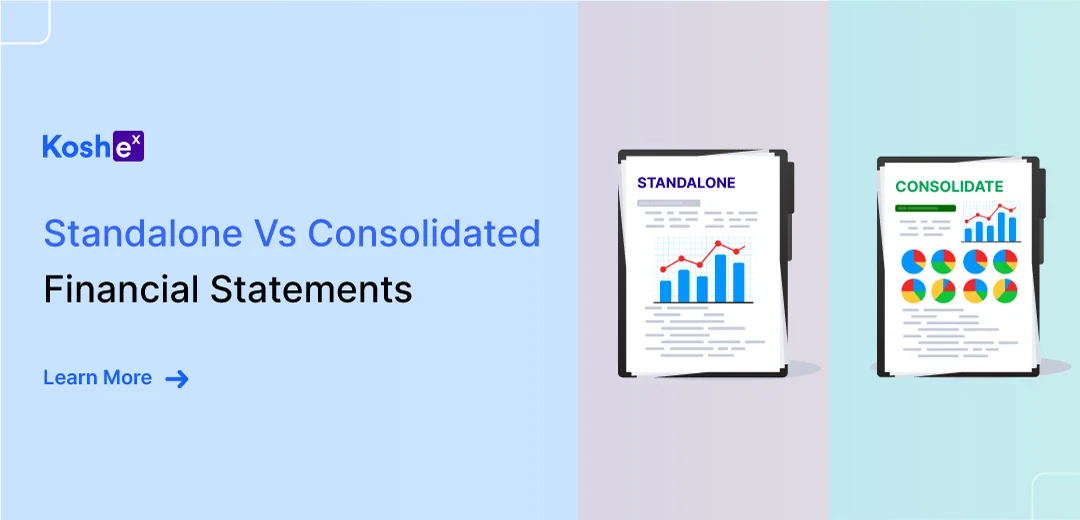As a newbie in the financial world, one might have spent ample time figuring out the difference between companies’ standalone and consolidated financial statements.
Chances are high that despite spending a lot of time on this topic, people still have a few ambiguities about these financial statements. So let us dig deeper and understand how these differ from each other. But first up, what is a financial statement?
A financial statement is a formal document that summarizes the financial activities and performance of a business, organization, or individual.
Financial statements play a crucial role in market-linked investments, such as investing in stocks, mutual funds, and more. Further, financial statements give a plethora of information about companies’ financial positions, like
· How efficient is the company in converting its revenue into profit?
· How many liabilities does the company have?
· Is the company managing its operating expenses well?
· Where is the profit heading quarter after quarter?
Standalone financial statement
A standalone financial statement gives the company’s financial performance for a particular period as a single entity. It doesn’t include the financial performances of its joint ventures, subsidiaries, or associates.
Consolidated financial statement
Unlike a standalone financial statement, the consolidated financial statement of a company includes the financial performance of the parent company along with its joint ventures, subsidiaries, and associates for a particular period. For instance, the consolidated financial statement of Reliance Industries consists of the financial performances of its following businesses:
· Jio Platforms
· Reliance Retail
· Network18 Group
· Reliance Petroleum
· Alok Industries
· Indiawin Sports
· Other businesses
Some financial terms for a better understanding:
· A parent company is a firm that has one or more subsidiaries.
· A subsidiary company is a firm with over 50% of its controlling stake owned by another company known as the parent company. If the parent company owns a 100% stake in a firm, it’ll be called the wholly-owned subsidiary of the parent.
· If a parent company owns a 50% or lower stake in another firm, then it’ll be known as an associate company of the parent.
· A group company is an economic entity formed by a parent company and all its subsidiaries.
· The consolidated financial statement of a company includes the consolidated balance sheet, the consolidated cash flow statement, the consolidated profit and loss account and notes, other statements, and explanatory material. Typically, consolidated financial statements are delivered, to the maximum extent possible, in the same format as adopted by the parent for its standalone financial statement.
Why must companies release standalone and consolidated statements separately?
Companies in India release standalone and consolidated financial statements separately to comply with the accounting standards and regulations set by the Securities and Exchange Board of India (SEBI) and the Ministry of Corporate Affairs (MCA).
Under the Companies Act, 2013, companies are required to prepare and disclose standalone financial statements, which provide information about the financial performance and position of the individual entity. These standalone financial statements include a balance sheet, income statement, cash flow statement, and statement of changes in equity.
In addition to standalone financial statements, Indian companies are also required to prepare and disclose consolidated financial statements in compliance with the Indian Accounting Standards (Ind AS). A company must prepare a separate consolidated financial statement if a company has one or more joint ventures, subsidiaries, or associates. This rule applies to both unlisted and listed companies.
Consolidated financial statements are mandatory because:
· It is in line with international financial reporting standards.
· To provide investors with financial information about the group as an economic unit. Besides, standalone financial statements do not give a clear picture of the economic activities of the group.
· Before the Act came into force, listed companies rarely released financial details about their unlisted subsidiaries. Hence, finding out how cash moved between the entities was difficult.
· They clearly show how money is moved between the parent company and its subsidiaries.
SEBI requires listed companies to disclose both standalone and consolidated financial statements in their annual reports. Overall, the separate disclosure of standalone and consolidated financial statements ensures transparency and accountability in financial reporting and enables investors and other stakeholders to make informed decisions based on a complete and accurate understanding of a company’s financial performance and position.
Standalone vs consolidated financial statements
| Consolidated Financial Statement | Standalone Financial Statement |
| A consolidated financial statement includes the financial performance of a parent company along with its joint ventures, associate companies, and subsidiaries. | A standalone financial statement provides only the financial information about the parent company. It does not include the financials of its subsidiaries, joint ventures, or associate companies. |
| From an economic entity perspective, the consolidated financial statement is considered the primary financial statement. | The standalone financial statement gives only the individual performance of the company. Hence, more is needed to understand the group’s financial condition. |
| A standalone financial statement provides only the financial information about the parent company. It does not include financials of its subsidiaries, joint ventures, or associate companies. | Analysis based on the standalone P/E ratio will be incomplete. But, if one wants a peer comparison of companies, he must use the standalone P/E ratio of peers. A higher P/E value indicates the stock is expensive. |
| Usually, investors check the P/E ratio of the company before making investment decisions. Therefore, before investing in a large company like Reliance Industries, check their consolidated P/E. | The consolidated financial statement is a broader concept. One can easily figure out how healthy the financials of the company and its subsidiaries are using this statement. And based on this, people can make the right investment decision. |
Standalone vs consolidated financial statements—which is preferable?
It’s always better to see things in a broader spectrum. Hence, analyzing the consolidated financial statement is highly advisable. It provides people with a complete idea about the financial health of the parent as well as subsidiary/associate companies.
The parent company will often run a profitable business, while some subsidiaries will be loss-making. In such a situation, the parent company will register a robust standalone financial performance while its consolidated performance may be turbulent. In this case, if one makes investment decisions based on the company’s standalone financial statement, his/her returns may soon be in the red zone.
In lieu, if individuals want to check how expensive the shares of a company are compared to its peers, they can consider standalone statements. But the comparison should be made only with the standalone statements of the other company.
Summing Up Consolidated vs Standalone
Both standalone and consolidated financial statements offer crucial data related to a company as they provide two different insights into the financials of a company. While making investment decisions, consider the financial performance of the subsidiaries and associates as well. Ignoring them while taking investment decisions may land you in troubled waters.
Analyzing the financial statement correctly is just the start of one’s investment journey. Undoubtedly, people need a trusted platform to make their investment journey successful.
Sign up with Koshex to grow your money exponentially.
FAQs
Where can I get the financial statements of a company?
You can find the financial statements of a company on its website. If the firm is a listed company, you can also find it on the websites of the exchanges in which it’s listed.
How often do companies release financial statements?
Listed companies release their quarterly financial statements after the end of each quarter and annual financial statements after the end of each financial year. However unlisted companies usually release only annual financial statements.









Leave a Comment